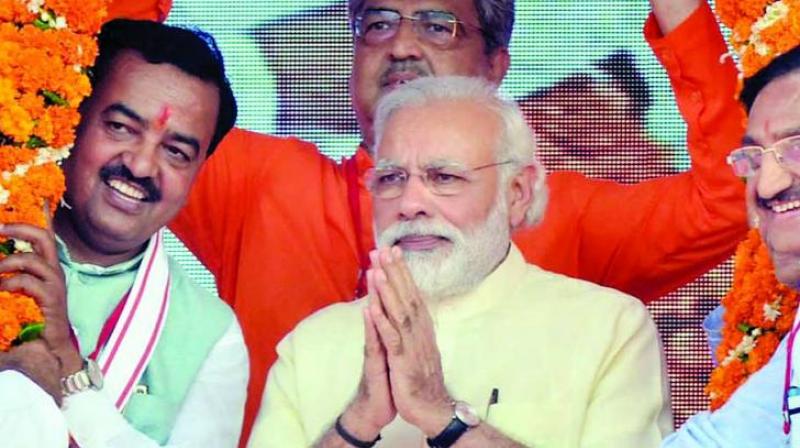UP polls: Repeating 2014 win in 2017 was not easy

Back-to-back media coverage of just concluded Uttar Pradesh polls quickly degenerated into a farcical urban legend, for every phase saw a new spin being given to what was happening on the ground. One heard that the Jats were upset with the BJP and had voted for other parties in the first phase. After the first three phases, again one heard that the BJP was behind.
After ‘kabristan’ and ‘shamshan’, BJP reportedly turned its campaign around. The battle for UP became battle of Varanasi in the last phase. One now heard that the BJP would emerge as the single largest party. But reports that BJP might lose the majority of Assembly seats in PM’s constituency left party cadre furious.
This was proved wrong with majority Hindu votes consolidating behind PM Modi. Although, I must add a caveat here, BJP insiders gave the party anything between 220 and 300, with party president Amit Shah confident of the higher number.
But the big question is where did the Muslim vote go? Muslim vote is approximately 18.6 per cent in UP and in parts of western UP as high as 45 per cent. BJP did not field a single Muslim candidate. The town of Deoband, home to the Dar-ul-Uloom, one of the tallest Islamic seminaries in the world, has a Muslim population of 71 per cent. Yet, BJP candidate Brijesh Singh garnered over 1,02,000 votes with a lead of nearly 30,000 over Bahujan Samaj Party’s Majid Ali. Only 25 Muslim candidates won – 19 from the SP/Congress alliance and six from BSP – down from 67 the last time and 56 in 2007. In the 143 Muslim seats where the community’s population is 20 per cent and above, BJP won 101 seats. The Muslim vote was divided between the SP/Congress and BSP political formations. Muslim votes got divided between Muslim candidates of SP and the BSP in seats such as Deoband, Chandpur, Moradabad Nagar, Noorpur, and Nakur.
However, Muslim candidates managed to win Meerut, Kairana, Naji-babad, Moradabad Rural, Sambhal, Rampur and Suar-Tanda. Muslim women voted in big numbers for the BJP over its stand on triple talaq.
Years of appeasement and pandering to a minority community seems to have angered the majority Hindus. A section of Muslims felt they are being used as vote bank. The consolidation of the Hindu vote phenomenon has happened thrice now in the last three years.
Muslim candidates won only 25 seats this time round. That Hindu Aandhi swept everything this time cannot be ignored. BJP “succeeded in getting votes of Hindu backward castes, Yadavs, Kurmis, Scheduled Castes, probably including Jatavs, and upper castes, which included Thakurs and Brahmins.
The narrative of national media in Delhi that the first phase was a washout for the BJP was proved wrong. Of the 73 seats in western UP, BJP won 66. In the second phase, the BJP was reportedly a distant third. But of the 67 seats, it won 50.
In the third phase of 69 seats, it won 55. Of the 209 seats in the first three phases, BJP won a staggering 171. In the next four phases, it actually did do well compared to the first three winning 154 out of 194. Against the backdrop of UP’s complex political scene and reverses BJP suffered in Bihar and Delhi, repeating 2014 Lok Sabha victory in 2017 was not easy.
Mr Shah offered tickets to 28 candidates from backward castes and allied with Apna Dal to woo politically disadvantaged sections. He sought to give the Dalits a strong sense of belonging by giving them important organisational roles.
Elections are episodic and not incremental, but the manner in which Hindu majoritarianism melded together to back the PM and BJP is revelatory. At the same time the manner in which analysts, pundits, psephologists and media got the Hindu mandate wrong is a shame. It is only two of the exit polls which presented the actual picture.

